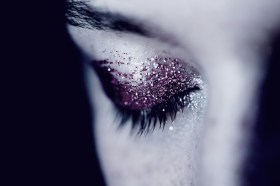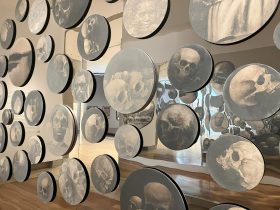The thought of touring a glass prize is a frightening one, but it is also an exciting option for a broader audience to experience the contemporary trends and artists defining this medium now.
The Fuse Glass Prize was established in 2016 as a biennial event, and has been part of core programming for Adelaide’s JamFactory.
But while it is Australasia’s richest prize for glass, and is recognised by the glass community internationally, it has not been toured outside South Australia until now.
Currently on show at Australian Design Centre (ADC) in Sydney, walking into the gallery the impression is immediately slick and sexy. The objects are displayed on stunning custom pedestals, and there is great nuance and diversity across the works on show – if anything, it is totally intriguing for the uninitiated.
Take for example the work of Cobi Cockburn’s (NSW), winner of the $20,000 prize. Murmuration (Light) 2019, is an incredibly subtle and skilled work, with intricately arranged hand-cut strips of glass in soft greys and whites that have then been fused to create a “painting” that would the envy of the likes of Agnes Martin.

Detail Cobi Cockburn, Murmuration (Light) 2019. Winner of The Fuse Glass Prize 2020. Photo ArtsHub.
Hung on a black wall, it is an ode to geometric abstraction and busts open all preconceptions of the glassy vessel. Many of the works in this year’s prize have a subdue palette, and many are opaque in a trend that pushes against the tradition of capturing colour through light that is quickly associated with studio glass.
Further thwarting preconceptions, to one side of Cockburn’s work is a highly conceptualised miniature glass shipping container by Canberra-based Jeremy Lepisto, and on the other, a suite of blown glass vessels by the celebrated Adelaide artist Clare Belfrage (pictured top). Their muted colours and ovoid pod forms are sensual, while the drawn quality of the cane work has a real earthy organic quality that is not normally associated with this fine technique.
Also worthy of mention is a sculptural piece by Nadège Desgenétez’s (ACT), Lucent (2018), which is a mysterious, amoeboid form with a pearlised finish.

Nadège Desgenétez’s (ACT), Lucent (2018). Finalist The Fuse Glass Prize 2020; installation view Australian Design Centre. Photo ArtsHub.
In her statement she describes a connection to place that is clearly personal, referential and emotive in its triggers. These are not the qualities we usually assign to hand-blown glass or slick abstraction, and it is this kind of conceptual framing and storytelling that makes the Fuse Glass Prize such an interesting survey.
This is further demonstrated in the emerging category, with a sculptural work by Hamish Donaldson (SA) inspired by water towers across the APY Lands. These towers have tapped into the water table since colonisation, and their complex duality is both a source of life and one draining spiritual waterholes.The table-like form is a great riff on the conversation.

Hamish Donaldson, Water Table #1 (2019), installation view Australian Design Centre. Photo ArtsHub.
There were 18 finalists, making this a very digestible exhibition. Joining Cockburn, Madisyn Zabel was selected as the winner of the David Henshall Emerging Artist Prize.
In the second gallery at ADC, and also biennial, is the Seed Stitch Contemporary Textile Award 2020. It is an initiative produced and presented for the second year by ADC, in partnership with the Seed Stitch Collective (Soraya Abidin and Niki McDonald).
The two exhibitions work extremely well together – not only for their obvious materiality but for the way both demonstrate new expressions of their mediums. It is as though, foremost, they take the conceptual role first – a contemporary framing – and then deliver the idea in a new approach.
For Seed, visitors enjoy works made from vines, metallic thread, recycled fabric, PVC safety barrier to felted forms – this is a broad and expressive genre. There is even an animated yarn work.
Perhaps demonstrating that contrast best, are two works by Liz Williamson, one created from eucalypt dyed silk and caught between a genre of landscape and geometric abstraction, and the other an exciting departure for the artist created from black nylon monofilament waste, and has the irreverence of an unfinished woven vessel.

Installation view two works by Liz Williamson; installation view Seed Stitch Contemporary Textile Award 2020. Photo ArtsHub.
Waste explores themes across the repurposing of materials, taking a modern material like monofilament to the loom, an ancient technique. Having made work since the 70s, Williamson again demonstrates the depth of the textile medium for experimentation and new expression.
Winning the prize, however, was a petite work by Brenda Livermore, Arise 2020, created from handmade mulberry paper string and encaustic wax. A threaded string of blackened seed pod forms, they form a continuous line of ongoing growth and regeneration. It is a particularly current narrative as NSW recovers from the year’s bushfires.

In Front: Brenda Livermore, Arise 2020. Winner Seed Stitch Contemporary Textile Award 2020. Photo ArtsHub.
Worthy of mention was Sue Wright’s installation Sign of Time, embroidered Auslan signing gestures on silk. The gallery explains: ‘Inspired by the language that she feels saved and enriched her life, Sue creates artwork in an attempt to break the barriers between the two worlds.’
Taking the Innovation Award was Tina Fox’s Electric Sheep, inspired by Philip K Dick’s science fiction novel Do Androids Dream of Electric Sheep. Animating an almost nostalgic ‘pastoral sampler’ in traditional crochet, Fox points to a crafted digital future with this work.
‘The binary nature of filet crochet, with its open and closed squares, is used to create a simulation of pixelated imagery and to generate a hybrid expression that is both textile and digital,’ explains the gallery.
A trained architect, designer and artist, Fox creates cross-disciplinary works that fuse technological boundaries with hand craft techniques.

Installation view Tina Fox’s Electric Sheep, and in rear Suzanne Davey’s Taking Flight. Photo ArtsHub.
Again, the prize has been hung beautifully, with a gentle supply of air creating movement of some works, and allowing the colour and shadow to have life.
This year the competition attracted 49 entries from NSW textile artists, with 25 selected for the finalists’ exhibition, which will also travel to Tamworth Regional Gallery from 28 November to 2 February 2021.
In COVID times, when many of us have turned to making and exploring, this is a great exhibition to inspire.
4 ½ stars out of 5 ★★★★☆
FUSE Glass Prize and Seed Stitch Contemporary Textile Award 2020Australian Design Centre NSW
9 October – 17 November 2020





